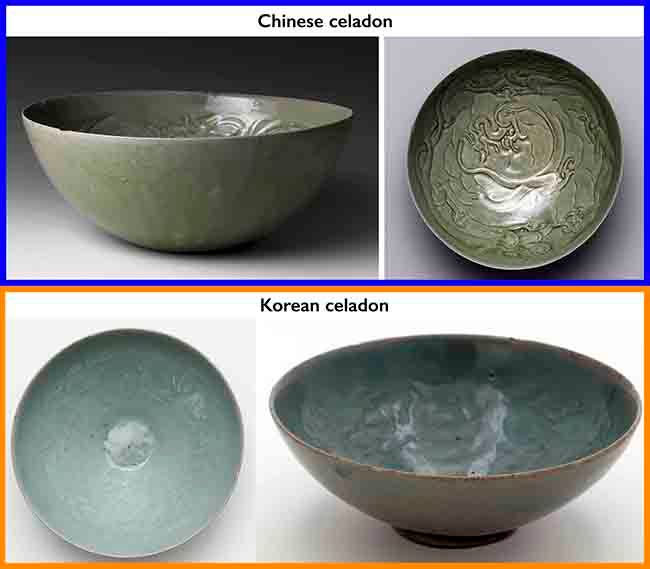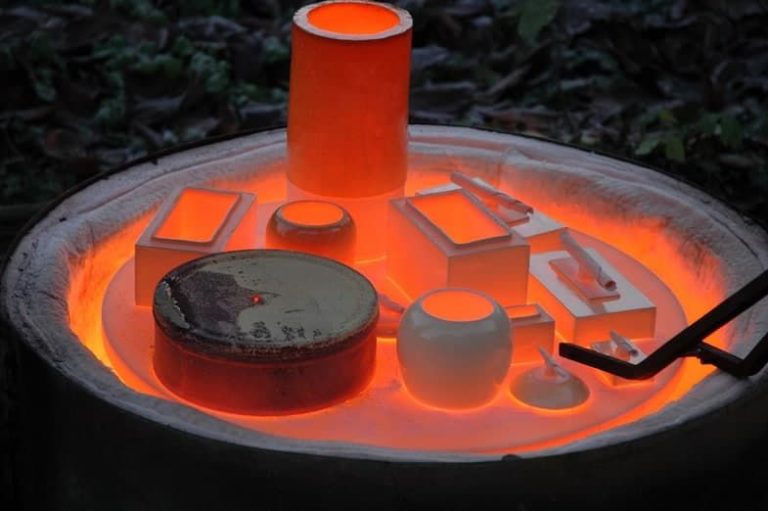What Is Celadon Glaze?
What is Celadon?
Celadon refers to a glaze typically used on ceramic and porcelain wares that results in a distinctive blue-green color. The name comes from the French word céladon, which was taken from the character Celadon in Honoré d’Urfé’s 17th century novel L’Astrée. In the story, Celadon wore green-tinted ribbons, and the term came to be used for ceramics with a similar greenish hue.
The origins of true celadon lie in ancient China. Glazes with a blue-green color were developed as early as the Han Dynasty (206 BC–220 AD), but celadon production flourished during the Song Dynasty (960-1279 AD). Longquan in southern China became known for its fine celadon wares exported all over Asia and beyond. The technique spread to Japan and Korea where unique regional celadon styles emerged.
The distinctive color is achieved by firing clay vessels with an glaze containing a very small amount of iron oxide at high temperatures in a reduction atmosphere. This produces the prized transparent blue-green tone, resembling jade. The color can range from pale green to deep blue, depending on factors like the clay composition, glaze ingredients, and kiln conditions.
Authentic celadon is highly valued for its elegant color and resilience. The glaze is durable and displays a subtle luster. Finely potted celadon wares with delicate designs are treasured by ceramic collectors and museums around the world.
Celadon Glazing Techniques
Celadon glazes achieve their distinctive sea green color through the use of iron oxide in the glaze recipe and firing in a reduction atmosphere (Ceramic Arts Network). The iron acts as a chromophore, imparting color to the otherwise colorless glaze. Typical materials in a celadon recipe include feldspar, silica, kaolin, and whiting. The feldspar acts as a flux while the silica and kaolin provide the glassy quality. Whiting is added for opacity (Ceramic Arts Network).
To create the celadon glaze, the raw materials are mixed together with water to form a slurry. The glaze is applied via dipping, pouring, or spraying in multiple thin layers. Often 3-5 coats are applied to achieve the desired effect. Once applied, the bisque ware must be fired in a reduction kiln. The atmosphere causes the iron oxide to change from reddish Fe2O3 to bluish green FeO, creating the characteristic celadon color (Derek Au). Careful control of the reduction firing is necessary to achieve the perfect sea green celadon.
The composition and layering of the glaze along with the firing atmosphere all contribute to the final distinctive celadon color so prized in ceramic arts (Ceramic Arts Network). Skilled ceramic artists have refined the glazing and firing process over centuries to reliably produce beautiful celadon glazes.
Types of Celadon
Celadon refers to a broad range of ceramics produced in various regions and time periods, resulting in several distinct types of celadon ware. Some of the most significant types include:
Longquan celadon: Originating in the Longquan region of China during the Song dynasty, Longquan celadon is known for its pale green glaze and refined craftsmanship. Longquan ware often features carved, molded, or incised exterior decorations under a thick glaze.
Chinese celadon vs Korean celadon: While both traditions produce stunning green-glazed ceramics, Chinese and Korean celadons have some distinctions. Chinese celadon glazes often appear more blue-green compared to the gray-green hues of Korean celadon. Chinese celadon also utilizes more diverse shapes while Korean celadon is often simpler in form.
Crackle celadon: Crackle glazes feature a delicate network of cracks in the glaze surface. This effect is achieved by varying factors like glaze thickness and composition. The Song dynasty Yaozhou celadon is particularly prized for its crackle glaze qualities.
Celadon Pottery
Celadon pottery refers to the green glazed ceramics that were produced in ancient China and various parts of Asia from the 10th to 14th centuries. Celadon wares come in a variety of shapes and sizes and were used for both utilitarian and decorative purposes.
Celadon glazes could be applied to plain ceramic bodies to create a solid green color, or patterned celadon which combines the green glaze with decorative techniques like carving, incising, or slip-trailing to create ornate designs and patterns. Some of the most notable celadon wares include:
- Longquan celadon – Prized for its pale green “sea-foam” color, produced in the Longquan kilns of Zhejiang, China during the Song dynasty. Forms include bowls, dishes, vases, incense burners. Wikipedia
- Yue ware – Elegant light green celadon with subtle designs, produced in Yue kilns of Zhejiang during the Song dynasty. Mostly bowls, dishes and ewers. Study.com
- Goryeo celadon – Highly prized Korean celadon notable for its jade-like quality and inlaid designs. Produced during the Goryeo dynasty. Common forms are vases, bowls, bottles. Wikipedia

Celadon glazed ceramics were a hallmark of ancient Asian artistry and remain prized by collectors today for their elegant forms and mesmerizing green hues.
Celadon Decoration
Celadon wares are distinctive for their decorative techniques, which evolved over time. The most common techniques for decorating celadon were carving, incising, and stamping.
Carving involved carving away sections of clay from the leather-hard unfired ware to create a sunken design that would hold glaze. Intricate carved floral and cloud scroll designs were common motifs, revealing the light green glaze in the recesses.
Incising was done by dragging tools through the clay surface to create shallow lines and patterns. Common motifs were plant forms, animals, and geometric designs. The incised lines would pool with a thicker glaze, accentuating the decoration.
Stamping was done by pressing pre-carved stamps into the clay. Repeating patterns of stylized flowers, birds, clouds, and waves were created through stamping.
Celadon glazes were admired for their jade-like colors and unique effects. The glaze pools deeply in carved areas, creating a striking contrast between the thick jade color and the pale green of the bare clay. Fine crackle effects are another distinctive glaze feature seen on some celadon.
The combination of the carved clay and vivid glaze effects made celadon decoration highly prized. It represented the immense skill and artistry of celadon potters through the centuries.
Noteworthy Examples
Celadon pottery has been produced for centuries, and some of the most famous and prized examples come from ancient China, Japan, Korea, and Southeast Asia.
One of the most celebrated celadon wares is from the Chinese Longquan kilns during the Song dynasty. Longquan celadon was highly valued for its elegant green glazes and masterful shapes like carved dragons and phoenixes. Many Song Longquan vases and bowls can be seen in museums like the National Palace Museum in Taipei and the British Museum in London.
The Chinese Yue ware from the Five Dynasties and Ten Kingdoms period is another remarkable celadon. It often features crackled blue glazes over the green and expertly potted shapes. Stunning Yue pieces are part of collections at the Shanghai Museum and Taipei’s National Palace Museum.
In Japan, the oldest surviving celadons were produced at the Tokoname and Seto kilns starting in the 12th century. Their ash and iron glazes create lovely patchwork greens and blues. Superb examples are preserved at the Tokyo National Museum and Kyoto’s Miho Museum.
For Korea, the most acclaimed celadons came from the Koryo dynasty when ceramics production reached an artistic peak. Koryo celadons like the famous blue and white “Tenmoku” wares can be admired at the National Museum of Korea and several celebrated pieces are national treasures.
Celadon Symbolism
Celadon has long held symbolic meaning in art and culture. The delicate, pale green hue is associated with nature, tranquility, and spirituality.
In China, where celadon originated, the color took on special significance. Celadon glazes were used to create porcelain wares for the imperial court during the Song dynasty. The color came to symbolize elegance, refinement and nobility. Only the emperor and his inner circle were permitted to see and own celadon wares, adding to its mystic allure. Celadon came to represent benevolent rule and the Mandate of Heaven in Chinese culture.
Celadon also has deep spiritual symbolism. The pale green is reminiscent of new growth in spring, symbolizing rebirth and renewal. It is considered a restful, harmonious color, associated with healing and balance. In feng shui, celadon promotes tranquility and relaxation. Many meditate surrounded by celadon tones to induce inner peace. In traditional Chinese medicine, celadon corresponds to the liver meridian, promoting healthy qi flow in the body.
Today, celadon continues to have symbolic meaning in art and culture. It is still seen as an elegant, historic color, hearkening back to ancient Chinese arts. Celadon glazes create a refined, subtle aesthetic for modern potters and designers. The soothing palette promotes tranquility and balance in living spaces. Celadon jade is also prized in jewelry for its symbolism of healing and spirituality.
Modern Celadon
Celadon glazing techniques have continued to evolve in the modern era. Contemporary ceramic artists have innovated by creating new glaze recipes and surface effects.
One noteworthy contemporary celadon artist is Japanese potter Fukami Sueharu. Fukami revitalized the celadon tradition in the late 20th century by developing his own unique recipes and finishing processes. His pieces combine ancient celadon glazing with modern shapes and decorative elements. For example, this elegant vase features Sueharu’s signature crackle glaze in a soft green celadon tone.
Other contemporary artists such as Kato Tsubusa have built upon the celadon legacy by creating novel mixed clay and glaze combinations. These innovations breathe new life into the ancient celadon traditions.
Caring for Celadon
Korean celadon is a delicate pottery that requires special care and handling to preserve its beauty. According to the Korean Arts website, celadon should be wiped with a moist cloth occasionally to remove dust, and kept out of direct sunlight to prevent fading (source). The glazed surface is prone to chipping if handled roughly. When moving celadon pieces, carefully pick them up with both hands cradling the base.
If small chips occur, they can often be restored. As shown in a YouTube tutorial, start by cleaning the damaged area with a damp cotton swab. Allow it to fully dry. Then use a very fine tipped brush or toothpick to apply a small amount of clear nail polish to the chip. Let it dry completely. Gently buff with a soft cloth to blend the repair into the surrounding glaze. Multiple thin layers may be needed for larger chips (source). Avoid over-repairing as this risks ruining the look of the antique glaze.
With proper care, celadon can remain undamaged for generations. Follow handling guidelines to preserve the fragile beauty of this traditional Korean artform.
The Legacy of Celadon
Celadon has a rich historical legacy and influence, especially in East Asian cultures. The technique of creating celadon glazes and ceramics originated in ancient China during the Han dynasty around the 10th century BCE. Over the centuries, celadon production spread to Korea and Japan, with each culture developing their own unique styles and techniques. Celadon ware reached its peak popularity during the Song dynasty in China, when the imperial court favored its elegant green-blue colors.
Celadon ceramics came to symbolize nobility, spirituality, and sophistication in East Asia. The glaze’s resemblance to jade was particularly prized. Finely crafted celadon objects were coveted by scholars, aristocrats, temples, and the ruling elite for centuries. The difficulty of controlling the firing conditions to create the signature celadon colors added to its prestige as only master artisans could produce quality pieces.
Today, celadon continues to be highly valued by collectors around the world. Antique celadon wares from China, Korea, and Japan are prized for their rarity and beauty. Contemporary ceramic artists also work in the celadon tradition, creating new interpretations while preserving the old techniques. Celadon glazes require great skill to perfect, making modern examples impressive demonstrations of artistic mastery. The striking colors and natural patterning give each celadon piece a unique personality that enthralls collectors.
With its long history and artistic significance, celadon remains an important ceramic tradition that connects the past to the present. Celadon’s legacy is a remarkable story of innovation, beauty, and human creativity echoing across centuries.

